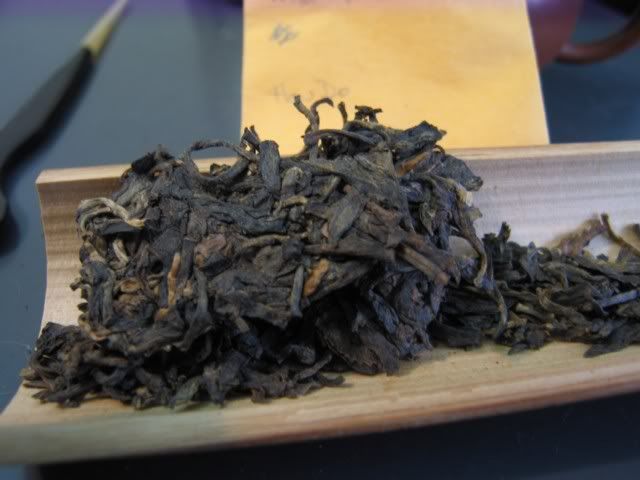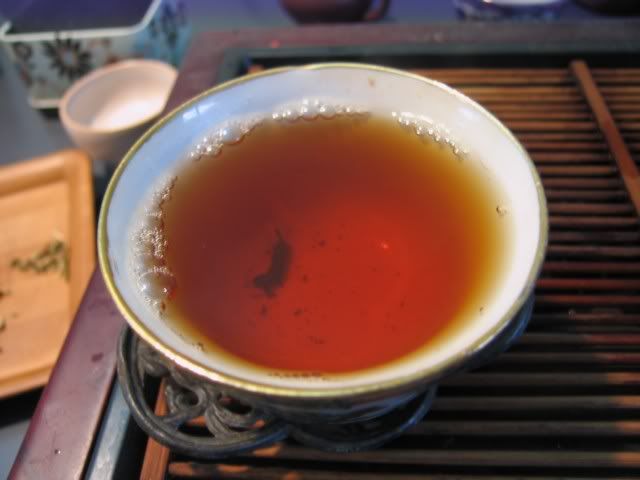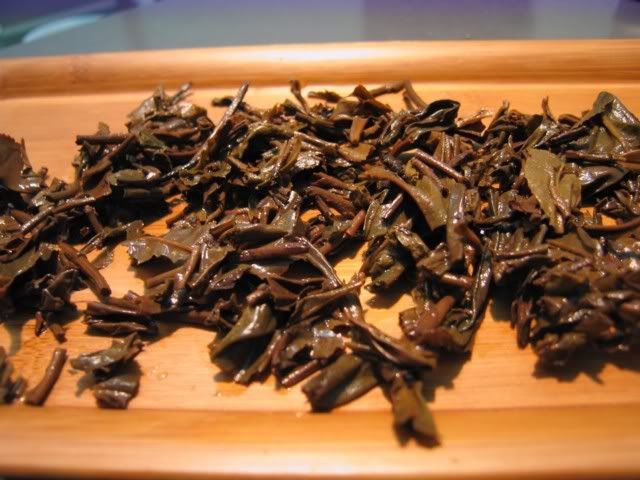Dredging up more old samples, only this one’s even older.

According to the envelope in which it came, it is a 1999 Menghai Yiwu wild tea, from Hou De via Davelcorp. This is, if I remember correctly, one of the very first samples I received after I started the blog, which would mean that it has been sitting in my pile of stuff for about two years. The leaves smell slightly musty, but not too much.

It brews a brownish colour, normal given the age and I think storage conditions, which I would consider “normal” storage — not too wet, not too dry. The taste fits the colour and age as well — sweet, mellow, a bit of bitterness, but none too overpowering. In fact, I’d describe the tea in general as rather mellow and subdued. It’s not something that would wow you, nor is it a tea that will hit you over the head with an overpowering bitterness, strength, or anything. Rather, it delivers a steady, if slightly boring, taste that suits its current, slightly awkward age.

I do think the tea can use some more time before being consumed. Right now there is just a hint of that aged goodness that is coming through, but it’s not there yet. At the same time though, I do wonder about those wild tree claims. The tea doesn’t linger in the mouth much — aftertaste is slight. Much of the action happens on the tongue and remains there. That, from what I understand anyway, is more a sign that it is plantation tea than anything else. The wet leaves don’t tell much, apart from the fact that things are a bit broken and some leaves are paper thin. Menghai never really produced stuff that look great when wet though, so it doesn’t say much.
Then again, I think two years ago when this thing was still on sale at Hou De, prices were not outrageous. It’s long gone, of course, and it seems that Hou De no longer stocks anything of this sort, preferring instead to deal in high priced current-year puerh in fancy packaging, or older teas that have been heavily advertised (and thus carry a huge premium in many cases). There are, I think, still gems out there to be had that don’t demand an arm or a leg in return, but those teas, it seems, are hard to find in the online shopping mall for tea.

2 responses so far ↓
Anonymous // March 16, 2008 at 2:54 am |
I’m not sure how is the tea affected, when you keep it for years. Yes, I know, that pu-erh should age, but I do believe, that a sample of 5-15 grams does not have the needed microclimate to age correctly – it can easy stale. I believe, that keeping samples in long-term can degrade their quality.
Also, if you claim, that Guang does not sell cheap aged tea – who does?? Isn’t it just because there aren’t that kind of tea for sale? The pu-erh market awfully changed in last two years.
MarshalN // March 16, 2008 at 9:22 am |
Hi Tomas,
I am not saying this particular sample was aged well in any way, and I don’t want to make it sound like this is indicative of the cake in general — just the sample. Since the tea has long been sold out, I have no way to check. Yesterday’s Dadugang tea turned out to be quite similar to Walt’s own impression after he tried it from his remaining cake, which I think should probably be at least 200g or so since only 10 samples were sent.
As for cheap aged tea, I think you might have misinterpreted what I said. When this tea was sold it was a 5-6 years old tea. The only teas of around this age that Hou De sells these days is the 99 Yichang Hao or that kind of thing — teas that everybody knows about because they were heavily marketed in the press in the past few years, and prices are consequently very high. Look beyond those “star” cakes from 1999-2001, and there are others that, at the very least, are much cheaper than these “stars”. There are also, I think, stuff from 01-04 that can be quite decent without costing you a big bundle. You rarely see those though. When it’s possible to buy, in Taiwan, a cake of early 90s to mid 90s Menghai 7542 or Zhongcha Traditional Character for less than these 1999 “star” cakes…. you start thinking about priorities.